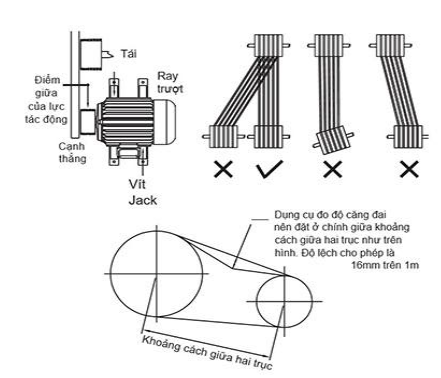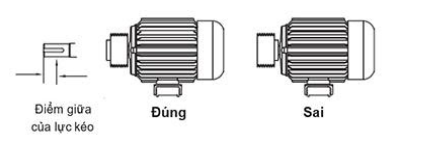Thank you for choosing Toan Phat Mechanical Co., Ltd.'s single-phase squirrel-cage induction motor.
Before operating the motor, customers should carefully read this user manual and thoroughly review the technical specifications indicated on the motor label.
1. Motor Installation
- Ensure the motor is installed in a cool, dry place, free from steam and chemicals that could reduce motor durability (except for specially designed motors with specific codes).
- Ensure the motor’s ventilation path is unobstructed.
2. Assembly
a. Coupling Assembly
-
The coupling is mounted on the shaft by heating or directly pressing onto the shaft end. When pressing the coupling onto the shaft, ensure protection for the rear end of the shaft to avoid damaging the bearings and other components.
-
Ensure the alignment of the two shafts.

-
The angle between the motor side coupling and the load side coupling should be zero.
-
The system should rotate the coupling smoothly after assembly; improper assembly can lead to shaft breakage.
b. Pulley and Belt Assembly
-
The pulley is mounted on the shaft by heating or directly pressing onto the shaft end. When pressing the pulley onto the shaft, ensure protection for the rear end of the shaft to avoid damaging the bearings and other components.
-
Ensure the parallel alignment of the motor shaft and the driven machine shaft during installation. The belt should not be too tight to avoid excessive force on the shaft, negatively affecting the bearing.
-
Proper assembly ensures an even distribution of belt tension across the pulley and shaft.

-
The pulley should be tightly fixed on the shaft, always flush against the shaft shoulder.
-
Generally, the main load point on the pulley should be at the midpoint of the shaft end.
 II. Pre-Operation Inspection
II. Pre-Operation Inspection
After installing the single-phase motor, check the following before operation:
1. Mechanical Inspection
-
Ensure all connections are secure and meet technical requirements.
-
Ensure the motor shaft can rotate freely before initial startup.
-
Rotate the motor shaft at least one full turn to ensure no contact between rotating and stationary parts.
-
Tighten all bolts and nuts on the motor and the driven machine, and secure the four mounting bolts or flange to the support or equipment.
-
Ensure no loose parts that could be thrown off by the motor’s cooling fan.
2. Electrical Inspection
-
Ensure all electrical connections are secure and continuous.
-
Check the operation of overload protection devices, switches, fuses, or other protective devices to ensure proper startup characteristics.
-
Verify that the supply voltage and frequency match the motor’s specifications on the label.
-
Check the connection diagram in the motor’s terminal box, ensuring all main motor connections are secure and not short-circuited or grounded.
-
Ground the motor housing via the ground bolt.
-
Open the motor’s terminal box and use a 500V Megger to check the insulation resistance between phases and between phase and housing. The insulation resistance should be Rcđ Phase-Housing ≥ 10MΩ.
-
If the insulation resistance is below this value, dry the stator windings until Rcđ is reached before connecting to the power supply for operation.
-
Ensure the wires connected to the motor meet insulation and cross-sectional area requirements as specified in the table:
| No. | Motor Power | Wire Gauge per Phase (mm²) |
| 1 | 0.18 kW - 0.37 kW – 220V | ≥ 1.0 |
| 2 | 0.55 kW - 0.75 kW – 220V | ≥ 2.5 |
| 3 | 1.1 kW - 1.5 kW – 220V | ≥ 3.0 |
| 4 | 2.2 kW - 3.0 kW – 220V | ≥ 6.0 |
| 5 | 3.5 kW – 220V | ≥ 10 |
Wiring Diagram for Single-Phase Squirrel Cage Induction Motor:

III. Operation
-
Before starting the motor, ensure the terminal box cover is closed securely and clear the area of any installation tools or materials.
-
Ensure the motor housing is grounded.
-
Ensure the applied load is within the motor’s specifications.
-
Ensure the motor’s working environment is dry and cool, preventing water, oil, or other substances from entering the motor.
-
After starting, if the motor runs smoothly without vibrations or unusual noises, it is ready for operation. If any issues occur, stop the motor and recheck the mechanical and electrical installation. Throughout the operation, constantly monitor the motor to prevent any unexpected problems.
-
IV. Motor Storage and Maintenance
1.Storage
After a period of operation or long-term inactivity, the motor should be stored as follows:
-
Keep the motor clean, preventing dirt buildup that can cause rust and reduce motor aesthetics.
-
Store the motor in a dry place, protecting it from environmental factors like rain or humidity to maintain stator winding insulation.
2. Maintenance:
-
Lubricate bearings.
-
After approximately 3 hours of operation, check the bearing temperature. Follow the bearing manufacturer’s instructions for operating temperature and grease replenishment. After 4000 hours, clean the bearings with industrial oil and replace the grease, filling 1/3 to 1/2 of the bearing chamber.
-
Follow the motor maintenance schedule.
| Task Description | Work Details | Maintenance Frequency |
| General Inspection | Review the current operational status and safety system. | Weekly |
| Inspect Bearings and Drive Belts | Check wear and tear, adjust, repair, or replace as necessary. | Weekly |
| Check Motor-Related Components | Inspect for issues such as wear in couplings, bolts, and listen for unusual noises indicating possible faults. | Weekly |
| Motor Characteristics | Check motor parameters such as temperature, vibration, and compare with initial values. | Monthly (Weekly if necessary) |
| Clean Motor and Operation Area | Clean the motor and surrounding area to ensure efficient operation. | Monthly |
| Inspect Bearings | Ensure bearings are lubricated as recommended by the manufacturer. | Based on operating hours |
| Check Tightness in Terminal Box | Check and tighten all electrical connections. | Monthly |

Comment